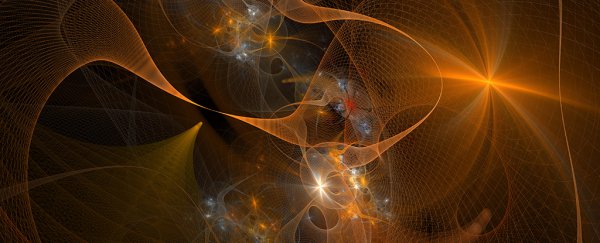Launch yourself from a great enough height and it won't take long to see which would win in a battle between gravity and the forces that bind solid ground.
Gravity's relative weakness, at least compared to the strength of electromagnetism and the nuclear forces, appears to limits its power to phenomena on the vast scales of planets and galaxies.
For this reason, together with the challenge of marrying general relativity with quantum physics, physicists tend to hand-wave gravity's role in the formation of particles by fudging it with a rather arbitrary correction factor.
Two physicists from the Institute of Gravitation and Cosmology at the Peoples' Friendship University of Russia (RUDN University) are now rethinking gravity's place among the building blocks of nature, searching for solutions to equations that would give this small force a bigger role in explaining how fundamental particles could emerge.
At first glance, it seems like an unnecessary search. For a typical elementary particle, like an electron, its electromagnetic pull is 10^40 times stronger than its gravitational might.
Including gravity's effects when describing an electron's movements around an atom's nucleus would be like taking a mosquito's impact into account when discussing a car crash.
Researchers Ahmed Alharthy and Vladimir V. Kassandrov think the mosquito might be more important than we give it credit for, at least on the mind-blowingly small level of the Planck scale.
"Gravity can potentially play an important role in the microworld, and this assumption is confirmed by certain data," says Kassandrov.
Established solutions to fundamental field theory equations in curving spacetime appear to leave room for a small but non-zero influence of gravity when we zoom in close. As distances shrink, gravity's tug eventually becomes comparable with that of attracted charges.
There are also models describing solitary waves forming in quantum fields in which the tiny effect of gravity could well help reinforce the wave.
The duo went back to semi-classical models of electromagnetic field equations, swapping out the hand-waved correction typically used and applying rules that allow them to tweak some quantities while ensuring others remain fixed.
By slotting in quantities defining the charge and mass of known elementary particles, the team went on the hunt for solutions that added up.
For the most part, there were no clear situations where gravity seemed necessary, at least for known particles.
But there were scenarios as distances shrank to around 10^-33 metres for charged objects with a mass of 10^-5 grams where solutions appeared.
The theorists aren't sure if their answers describe anything we might find in the Universe, though they do set some limits on a spectrum that corresponds with hypothetical semi-quantum particles called maximons.
Pushing the mathematics further, as electric charge vanishes into nothingness on the smallest of scales, and masses grow to a stellar-magnitude, it's clear that gravity becomes a key factor in the emergence of some objects from the quantum landscape.
That might sound like a flight of fancy, but such neutral matter-waves are the very things that make up hypothetical objects known as boson stars.
For now, gravity will continue to be reduced to a begrudging side-note in particle physics, its tiny force a mathematical complexity providing no appreciable benefit in its solving.
One day, we just might need to give the weakest of the four fundamental forces its due on the Universe's smallest scales.
"In the future, we would like to shed light on this problem that is intriguing for physicists but extremely complex from the point of view of mathematics," says Kassandrov.
This research was published in Universe.
